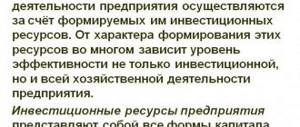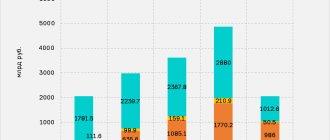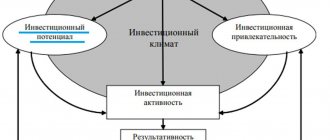Investments are characteristic of the capitalist foundation of the economy. The investment procedure involves investing funds of individuals and legal entities in profitable projects in order to make a profit. The demand for investment is driven by the need for the development of enterprises, their technological and material progress. Decisions to invest in a particular project are determined on the basis of economic forecasting.
To clearly understand the structure of demand for investments, their varieties should be taken into account. There are two of them:
- Potential
- Real
Potential demand, from a macroeconomic point of view, expresses the theoretical possibility of a particular enterprise to invest funds and expect dividends. Real demand means the quantitative expression of the actual need of individual areas and types of production for cash injections. The formation of real demand for external injections is due to the need to introduce new technological solutions in production.
Investments are characterized by the following phenomenon: the greater the demand for third-party funds, the more profitable the investment will be. This phenomenon further increases demand. But one factor alone is not enough. Economic theory examines various incentive measures. Moreover, both at the level of macroeconomics and within the framework of microeconomics.
By type of investment period, short-term and long-term investments are distinguished. Formal demand should also be distinguished. What reflects the formal demand for financial investments from outside?
This is the amount of money for investment, which is intended for implementation in the enterprise.
Demand factors
The need for resources is influenced by:
- economic situation in the country (world);
- state of the industry;
- financial stability of the company itself.
Two groups of factors can be distinguished: primary and secondary.
Basic
The investor risks his own or credit funds not just to develop the project, but to receive income. Therefore, the need for resources primarily depends on the planned profit from them.
Minor
In addition to potential earnings, the following factors should be taken into account:
- loan interest rate;
- real inflation;
- tax regime;
- public policy.
Macroeconomic indicators also influence investment demand. We are talking about exchange rates, unemployment levels, trade balances, sanctions. When purchasing foreign goods, the investor must be confident in the stability of the domestic currency exchange rate.
Prices for investment resources are also important. If the product line is currently quite expensive, move on to other projects in a different line of business.
Elasticity
The following factors influence supply and demand:
- price;
- average per capita income;
- crossover for interchangeable analogues.
The term explains the ability of the main economic characteristics and components to change and adapt to existing market conditions. The indicator is calculated on the basis of the coefficient, which reflects the ratio of changes in the volume of purchased goods relative to the adjustments made in its cost.
Do you want to implement Warehouse 15? Get all the necessary information from a specialist.
Thank you!
Thank you, your application has been accepted!
Sources of formation
Investment demand depends on the company's need to invest. This is the amount that the company is willing to allocate for the purchase of land, real estate, equipment, and so on.
Sources of funding may be:
- own;
- borrowed
It is preferable to invest your own capital, the loss of which does not threaten the business. As an option, you can consider loans from a bank, loan exchange, or individuals. But in this situation, the investor needs to carefully assess all the risks.
It turns out like this: an entrepreneur invests a certain amount in a bakery with a turnover of 100 units of product per day. The demand for products is high, all products are sold out by three o'clock in the afternoon. It turns out that production volumes can be increased by expanding the bakery area and purchasing equipment. Profit from investments is practically guaranteed according to calculations.
But in practice everything is not so obvious. I think it's better to risk your own small amount, if the investment pays off, then invest more.
Educational materials
The market on the scale of the entire national economy represents the unity and interaction of all the various markets for goods and services and scales: demand, supply, price.
To analyze the equilibrium in the national economy, it is necessary to combine into a single whole individual demand and supply, varying in volume and objects, into aggregate demand and aggregate supply of tens of thousands of different prices for various consumer goods and services, investment goods, raw materials, cash, etc. into a single aggregate price or price level. The volume of production in the macroeconomic equilibrium model characterizes the entire real volume of national production.
Aggregate demand (AD) is the quantity of goods and services, the volume of national production that can be realized at a given price level. Its value characterizes the real purchasing power of all subjects of economic relations at a given moment - consumers, enterprises and the state. For a closed economy, the amount of aggregate demand equals the sum of consumer spending (C), investment (In) and government spending (G). The relationship between them is described as follows:
In an open economy, aggregate demand increases by the amount of net exports (X n); equal to export (X) – import (M). That is:
There is an inverse relationship between aggregate demand and the general price level: the higher the price level, the lower aggregate demand (see Fig. 10.1).
Rice. 10.1 – Aggregate demand curve
P – price level; GNP – real volume of national production; AD – aggregate demand.
Aggregate demand depends on a number of factors not directly related to price changes. This could be a change in consumer income, a change in the taxation system, the possibilities and conditions for providing credit, the state of money circulation, the stability of the economic situation, etc.
These factors change aggregate demand, causing a decrease or increase in total spending by society at the same price level. Accordingly, there is a deviation (shift) of the demand curve to the left or right. Such non-price factors influencing aggregate demand include all factors that change the quantitative sizes of each of the components of aggregate demand. A change in each of these components of aggregate demand or several of them will lead to a corresponding change in the entire value of aggregate demand.
1. Changes in consumer spending not related to changes in prices for goods and services. Consumer behavior in the market is determined by many factors: the level of welfare and consumer expectations, the presence or absence of debt, the level of the income tax rate, etc. Thus, the expectation of an increase in income in the future period can stimulate the growth of consumer spending at the present time, which will lead to an increase in the total amount of aggregate demand and to a shift of the aggregate demand curve to the right (Fig. 10.2).
Rice. 10.2 – Change in the aggregate demand curve under the influence of growth in consumer spending
AO – aggregate demand before the increase in consumer spending; AD1 – aggregate demand after an increase in consumer spending; AD1 > AD
On the other hand, an increase in the income tax rate or high consumer debt reduces the real purchasing power of the population, reduces aggregate demand, and shifts the demand curve to the left.
2. Investment costs. The amount of investment spending is influenced by the level of interest rates, expected profits from investments, the level of taxes levied on enterprises, the efficiency of the technology used, the presence or absence of excess production capacity, forecasts of the expected capacity of the consumer market, etc. The need for technical modernization of production will stimulate investment and increase aggregate demand. If the income tax increases, then a decrease in investment will lead to a reduction in the entire value of aggregate demand and a shift to the left (Fig. 10.3).
3. Government spending. The state, by reducing or increasing spending on the military-industrial complex, construction, the implementation of social programs and scientific research, actively and directly influences the dynamics of aggregate demand.
Fig. 10.3 – Change in the aggregate demand curve with a decrease in investment expenditures
AD – aggregate demand before investment reduction; AD1 – aggregate demand after a decrease in investment; AD1 < AD
4. The value of net exports (the difference between exports and imports), its dynamics, not related to changes in domestic prices, depends on the level of national income of other countries and the ratio of exchange rates.
Aggregate supply (AS) is a certain amount of material goods and services produced by society and presented on the national market at a given moment at a given price level. Taking into account the price of the final product and its possible dynamics, the cost of production factors, the amount of capital, as well as available technology, firms determine for themselves the possible volume of production.
There is a direct relationship between the price level and the produced volume of aggregate supply: the higher the price level, the more economic goods will be produced, other things being equal (see Fig. 10.4).
Rice. 10.4 – Aggregate Supply Curve
P – price level; GNP – real volume of national production: AS – aggregate supply curve; Qf – potential volume of national production Qf >Qe. Qe is the real nominal product.
The aggregate supply curve consists of three segments: Keynesian - horizontal (A), classical - vertical (C) and intermediate (B). Let's look at each of them.
Keynesian segment. The horizontal position of this segment indicates that the increase in real production volume is not accompanied by an increase in prices and occurs at a stable level. The real volume of the nominal product (Qe) produced within the Keynesian segment is less than the potential volume (Qf) achieved under conditions of full employment. This is due to the fact that the economy has unused material and labor resources. Involving them in production in such a situation will have virtually no pressure on the price level.
Classic cut. Characterizes the real volume of production equal to the potential (Qf) produced under conditions of full employment. The economy fully utilizes its production capabilities available at a given time, and even an increase in the price level will not lead to a real increase in production.
Intermediate segment. In this segment of aggregate supply (between Qе and Qf), an increase in real output is accompanied by an increase in prices. This is due to the fact that the national economy is a collection of markets for a variety of goods and services. Some may be reaching potential output, while others may have untapped production capacity and significant unemployment. The redistribution of resources will in this case be accompanied by the involvement of less skilled labor in production, which will entail an increase in production costs per unit of output and an increase in prices for finished goods.
The considered aggregate supply curve characterizes the relationship between the price level and real production volume. A decrease or increase in aggregate supply can occur regardless of changes in the price level, and the entire aggregate supply curve will shift to the left or right.
Non-price factors also influence aggregate supply:
1. Changes in prices for the factors of production used. All other things being equal, an increase in prices for resources leads to an increase in costs per unit of production, and, accordingly, to a reduction in aggregate supply. The dynamics of resource prices depends on the presence or absence of domestic resources - land, labor, capital, prices for imported resources, etc. Thus, the company’s replacement of equipment or technology with more productive or economical ones, reducing production costs per unit of output, will also contribute to the growth of aggregate supply.
Rice. 10.5 – Change in aggregate supply as a result of equipment modernization:
АS – total supply before equipment modernization; AS1 – total supply after equipment modernization; AS1>AS
2. Changes in performance. An increase in the productivity of factors of production means that for a given volume of factors and other things being equal, it is possible to obtain a larger real volume of production and a larger volume of aggregate supply.
3. Changes in legal norms. Changes in legislation relating to the regulation of enterprises, their taxation, the procedure and conditions for issuing loans and subsidies, etc., directly affect the level of production costs. Thus, an increase in income tax will increase, other things being equal, production costs and lead to a decrease in aggregate supply.
Appendix: Key performance indicators of mining and manufacturing industries.
Keynesian concept of investment demand
The theory is based on the concept of “marginal efficiency of capital” introduced by J.M. Keynes. This refers to investment funds that are added to an existing amount. When deciding whether to invest, you need to compare the expected net profit flow with investment costs.
The net income stream is estimated by discounting. The probability of receiving a certain amount in t years is calculated by dividing it by (1+R) t. Where R is the discount rate.
The project will be economically profitable at the highest rate. As the volume of invested funds increases, the value of R falls, since the growth of invested capital reduces the expected profit.
How to set your rates
The main concept of pricing, planned in conditions of increasing profitability, is an understanding of how elastic demand will be. The desire to constantly increase consumer interest is quite natural for every competing company, which allows the most competent entrepreneurs to break into leading positions, but it is by understanding the criterion of size that one can occupy a large share of the market, offering their product or service at the most favorable and optimal price.
From this statement we can conclude that the products that are in greatest demand will bring great income to their owner. However, if you do not achieve high positions in the first stages due to a lower price tag, then the selling price will increase, and over time, the constantly increasing price will be due to the resulting inflation.
Economists view saving as the basis of investment. If income is considered not in monetary terms, but in physical terms, then income is divided into consumer and capital goods. The total output of capital or capital goods is called real investment, or investment demand.
Thus, if we imagine income as the sum of output, then investment demand depends, like consumer demand, on:
1) subjective factor - the decision of entrepreneurs to invest;
2) objective factors - interest rates, the level of change in output, profits, capital reserves and a number of other factors.
Cycle theorists attach great importance to the subjective factor, the propensity to invest, as the importance of the incentive factor for the investment activities of entrepreneurs. They believe that the propensity to invest is influenced by unexpected electoral victories of one party or another: Democrats or Republicans. Rumors, fears, even the president's illness can force a businessman to change his plans for investing capital, but have almost no effect on the plans of consumers.
So, savings form the basis of investment, so economists are faced with the task of finding the ratio between savings and investment that will ensure stable economic development for the country.
Macroeconomic models are based on one of the important provisions - the equality of savings with investments, i.e. the full implementation of the entire savings fund. This equality was first explored by Keynes.
Inequality between saving and investment was previously thought to be the cause of booms and busts in the trade cycle:
– if savings exceed investments, a depression or recession is inevitable;
– if investments exceed savings, there is a danger of an inflationary boom.
However, Keynes proved that saving and investment are always equal to each other, based on the premise that actual saving and investment are equal to the difference between income and consumption, therefore, they must be equal to each other, i.e.:
. (27)
Thus, the amount of savings is ultimately equal to the actual amount of investment (capital investment). If investment increases, then income increases enough to bring savings to the level of investment. Conversely, if investment is lower than saving, income will be reduced enough to bring savings equal to the level of investment.
How are they connected?
Economic science has long established a close connection between economic growth and the rate of investment. Moreover, it makes sense to talk about the existence of dependence. The volume of investment is a generally accepted indicator of the current state of the state's economy.
However, financiers rarely view the situation in static terms. The opportunity to analyze the factor of the influence of investment on economic growth appears only in dynamics. We are interested in the process in its development. Or, in other words, the dynamics of investment as a factor in the growth or decline of the economy.
Let's look at a specific example. The volume of foreign investment in the economy of the Russian Federation in 2012 amounted to 153.16 billion US dollars. In the same year, the country's GDP (gross domestic product) was 62.6 trillion rubles. This is static. We must accept this data as a fait accompli. But we cannot draw any conclusions based on them.
Now let's look at the situation as it develops. The volume of foreign investment in Russia in 2013 increased by more than 10% and amounted to 170.13 billion US dollars. GDP grew not so significantly, but still amounted to 66.7 trillion rubles.
In this example, we clearly see that investment and economic growth are interconnected. Through cash injections, it is possible to modernize the main means of production, increase the competitiveness of domestic goods, stimulate the development of certain sectors of the economy, and so on.
Company profit growth
The construction of an approximate demand curve is based on at least 2 pricing indicators and current sales volumes. The more factors are taken into account, the more accurate parameters can be calculated.
Using a strategy to increase the average check will be the safest in the conditions of an accurate analysis of the risks of losses due to the likely outflow of regular customers, and, accordingly, a shortfall in the expected profit. Based on basic knowledge, you can make the simplest calculations using the formula.
The manufacturer's income reaches its maximum value at the newly formed price only in the case when the change in the volume of goods sold, converted into a percentage value, is equal to the cost adjustment with the opposite sign, also displayed as a percentage. Thus, with a coefficient of elasticity of demand whose value is less than 1, a new increased receipt for products will entail revenue. If the value of E (elastic) is greater than 1, then it is necessary to reconsider pricing and reduce it.
Profit is one of the main indicators of the successful operation of an enterprise and the effectiveness of the chosen business methodology, but it cannot exist without logical pricing, at which revenue will be maximum.
The growth of the company's income will become real only under such conditions when the marginal profit indicator multiplied by the elasticity coefficient is equal to 1. If the expression is converted into a formula, it looks like this:
Where
- p – cost of one unit of products sold;
- c – production costs during the development and release of the product in question.
Impact of Bank Investments
In addition to the state budget’s own funds and attracted foreign investments, commercial banks have been and remain the source of funds for business. Their role in economic development is also difficult to overestimate.
The country's Central Bank must ensure that commercial financial structures create real opportunities for entrepreneurs to receive “long-term money.” This phrase is usually understood as long-term investments, due to which the development of small and medium-sized businesses in the country largely occurs. When issuing loans to companies for short and medium terms, commercial banks set the general interest rate prevailing at the moment. Businesses use this money to carry out their ongoing activities.
But in order for us to talk about economic growth, we need loans issued at fundamentally different interest rates. Such long-term investments provide a deferred multiplier effect. They are a stimulus for economic recovery. As a result, everyone will benefit. Companies, banks and the state budget.
Bottom line
If an entrepreneur plans to change the prices for his product, then this fact must be included as part of the marketing plan, since it reflects the associated costs. An increase is often associated with an improvement in the quality of products or services, which directly depend on financial investments, and a decrease is often associated with the release of new products to the market, for which minimum costs are calculated. Thus, all decisions related to pricing must be made taking into account the indicators and what factors influence supply and demand, as well as any possible changes - both temporary and with the prospect of transfer to a regular basis. Another important fact: with any innovations, the sensitivity, or more precisely, the solvency of potential and regular customers, should be taken into account. Every buyer strives to find products with an ideal price-quality ratio, so it is necessary to fairly evaluate trading opportunities.
Number of impressions: 14001
Conclusion
Based on the information provided, we can clearly conclude that investment and economic growth are closely related.
To boost the state's economy, sustainable and long-term investments in fixed capital are necessary. Their level should be sufficient not only to maintain its renewal. On the contrary, investments must ensure a complete and timely modernization of fixed capital. In turn, this will become the key to the production of innovative, competitive domestic goods.
This requires a clear and consistent economic policy to stimulate the investment process. In addition, coordination of joint efforts is necessary both on the part of representatives of large and medium-sized businesses, and on the part of government authorities. Only in such conditions can we talk about sustainable economic growth.
What is investment demand?
It is defined as the need of potential investors for additional capital to make a profit, purchase real estate or vehicles necessary for the production of goods or provision of services.
Do not forget that the goal of any investment is to make a profit, so this concept can be simply called the desire of investors to receive additional income.
Investment demand is a variable value. It is influenced by several factors that influence investor behavior.
Therefore, they distinguish:
- Potential investment demand, which represents the planned amount of expenses, for example, the part of retained earnings that the company plans to invest in investment activities. And it is not a fact that these investments will be realized.
- Real investment demand. This is a specific amount prescribed in the financial program. The funds will be used to develop the company under any circumstances.











